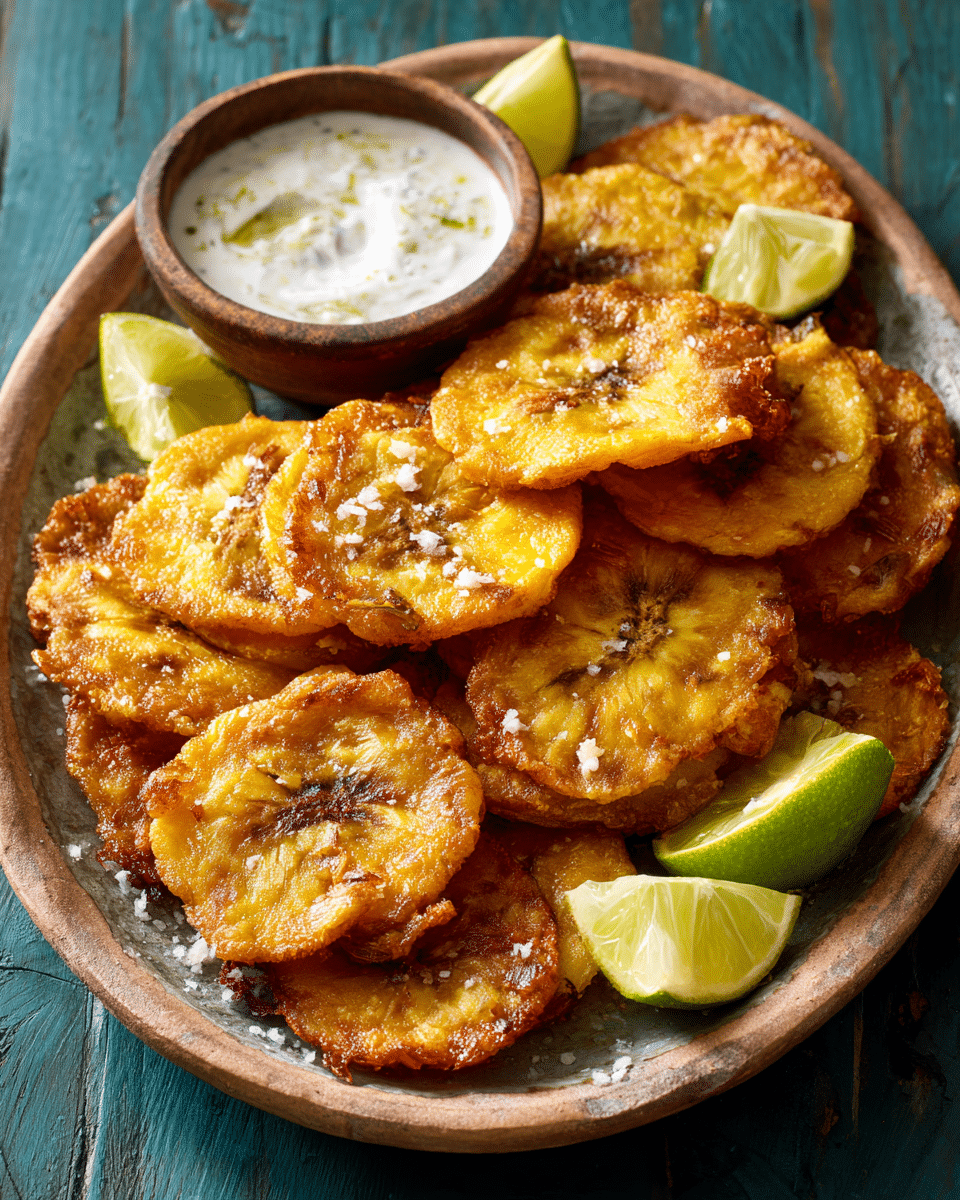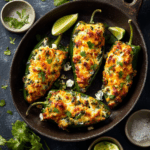Plantain tostones are a beloved snack and side dish throughout Latin America and the Caribbean. Made from green (unripe) plantains, they are sliced, fried twice, and salted to create irresistible crispy discs with a tender interior. Tostones are perfect for dipping, pairing with savory meals, or enjoying on their own. Their salty crunch and slightly starchy flavor make them a versatile and satisfying treat that’s easy to prepare at home.
FULL RECIPE
Ingredients
- 2 large green plantains
- Vegetable oil (for frying)
- Salt, to taste
- Optional: garlic powder or lime wedges for serving
Directions
- Peel the green plantains by cutting off the ends, slicing through the skin lengthwise, and carefully removing the thick peel.
- Cut the peeled plantains into 1-inch thick slices.
- Heat about 2 inches of vegetable oil in a heavy skillet or frying pan over medium heat until hot (around 350°F or 175°C).
- Fry the plantain slices in batches for about 3-4 minutes per side, or until they turn a light golden color but are not fully crispy. Remove and drain on paper towels.
- Using the bottom of a glass or a tostonera (plantain press), gently flatten each fried slice to about half its original thickness.
- Return the flattened plantains to the hot oil and fry again for 2-3 minutes per side, until they turn golden brown and crispy.
- Remove the tostones from the oil and drain on paper towels. Immediately sprinkle with salt to taste.
- Serve hot with optional garlic sauce, lime wedges, or your favorite dipping sauce.
Nutrition Facts
- Calories: 190
- Total Fat: 11g
- Saturated Fat: 1.5g
- Cholesterol: 0mg
- Sodium: 210mg
- Total Carbohydrates: 23g
- Dietary Fiber: 2g
- Sugars: 1g
- Protein: 1.5g
- Vitamin A: 2% DV
- Vitamin C: 10% DV
- Calcium: 1% DV
- Iron: 2% DV
Cultural Significance of Plantain Tostones
Plantain tostones hold a special place in the culinary traditions of many Latin American and Caribbean countries. Often enjoyed as a snack, side dish, or appetizer, they reflect the importance of plantains as a staple ingredient in these regions. The practice of frying plantains twice to achieve a perfect balance of crispiness and tenderness is a culinary technique passed down through generations. Tostones often accompany meals ranging from seafood dishes to hearty stews, showcasing their versatility and cultural value.
Choosing the Right Plantains
The secret to perfect tostones begins with selecting the right plantains. Green, unripe plantains are ideal because their firm texture and starchy flavor are best suited for frying. Unlike ripe plantains, which are sweeter and softer, green ones hold their shape well and crisp up beautifully when fried twice. When shopping, look for plantains that are mostly green with little to no yellow or black spots, as ripeness affects the final taste and texture of the tostones.
The Double Frying Technique
Double frying is the defining feature of tostones that gives them their signature crunch. The first fry cooks the plantains through without browning them fully, softening the interior. The slices are then smashed flat before being fried again, which crisps up the outside perfectly. This method ensures a golden, crunchy exterior while retaining a slightly tender center. Mastering this technique is crucial to avoid soggy or overly hard tostones.
Flavor and Texture Profile
Tostones offer a delightful contrast in texture with their crisp exterior and softer, starchy inside. Their flavor is mildly salty with a subtle earthiness from the plantain itself, making them an ideal canvas for seasoning. While plain salted tostones are delicious on their own, they also serve as a perfect base for additional flavors like garlic, lime, or spicy sauces, enhancing their appeal as a versatile snack or accompaniment.
Health Benefits of Plantains
Though fried, plantains do offer nutritional benefits. They are a good source of complex carbohydrates, providing sustained energy. Plantains also contain important vitamins like vitamin C and A, as well as potassium and dietary fiber, which supports digestive health. Choosing healthier oils for frying and moderating portion sizes can make tostones a balanced treat within a varied diet.
Common Variations and Enhancements
While classic tostones are simply salted, there are many regional variations that add layers of flavor. Some recipes include garlic-infused oil or a sprinkle of garlic powder immediately after frying. Others might serve tostones with dipping sauces like mojo (a garlicky citrus sauce) or avocado crema. Additionally, topping tostones with shredded cheese, seasoned ground meat, or fresh salsa transforms them into more substantial appetizers or snacks.
Pairing Tostones with Other Dishes
Tostones are incredibly versatile and pair beautifully with a wide range of dishes. They are commonly served alongside grilled meats, seafood, and stews, providing a crunchy contrast to tender proteins. Their mild flavor also complements fresh salads and creamy dips. Because of their salty crunch, tostones work well as a side for spicy or richly flavored main dishes, helping to balance and enhance the overall meal experience.
Serving Tips for Maximum Enjoyment
To enjoy tostones at their best, serve them fresh and hot. They tend to lose their crispness as they cool, so timing is important when planning meals. If serving as an appetizer or snack, offer an array of dipping sauces to elevate the flavor. Simple additions like a squeeze of lime juice or a sprinkle of chopped fresh herbs add brightness and freshness to the dish.
Storage and Reheating Advice
Tostones are best eaten fresh, but leftovers can be stored in an airtight container in the refrigerator for up to two days. To reheat and restore some of their crispness, bake them in an oven at 350°F (175°C) for about 5–7 minutes or lightly pan-fry them again. Avoid microwaving, as this tends to make them soggy. Proper storage and reheating ensure that tostones remain enjoyable even after initial preparation.
Advertisement
Common Mistakes to Avoid
When making tostones, several common pitfalls can affect the final quality. Using overripe plantains results in soggy, sweet tostones rather than crisp, savory ones. Frying at too low a temperature can cause the plantains to absorb excess oil and become greasy. Additionally, pressing the plantains too thin can make them fragile and prone to breaking during the second fry. Keeping these tips in mind helps achieve the ideal crispy texture.
Conclusion
Plantain tostones are a simple yet deeply satisfying dish that highlights the versatility of plantains in Latin American and Caribbean cooking. Their crispy texture, salty flavor, and ease of preparation make them a beloved snack and side dish worldwide. With room for countless variations and pairings, tostones offer endless possibilities for customization and enjoyment.






